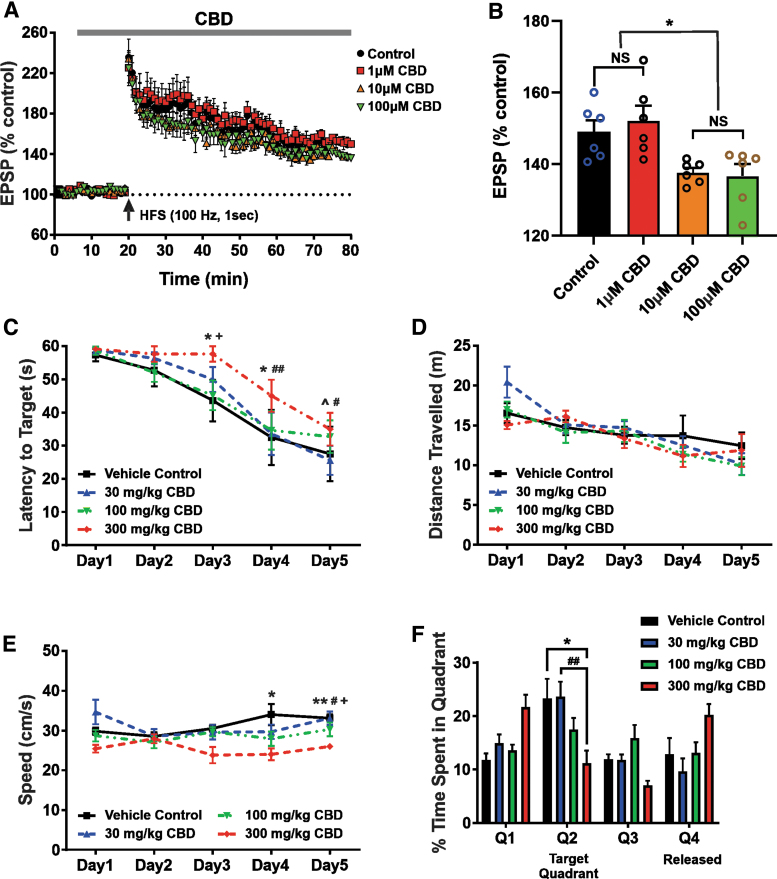FIG. 6.
High CBD doses exert impairment of hippocampal LTP and decrease spatial learning and memory in rodents. (A, B) CBD impairs hippocampal LTP in a concentration-dependent manner. (A) LTP recorded in hippocampal slices of C3HeB/FeJ mice administered to various concentrations of CBD. HFS (100 Hz, 1 sec) of Schaffer collaterals in CA1 hippocampus led to intact LTP formation when either physiological saline or 1 μM CBD was perfused. However, 10 and 100 μM CBD resulted in inhibition of LTP maintenance. The vertical arrow in this figure indicates the time point of HFS initiation. The dotted line denotes the average of the baseline EPSP amplitude during a 10-min physiological saline infusion before HFS stimulation. (B) Summary of changes in EPSP amplitudes at 60 min after HFS among the experimental groups (n=6 per group). Each vertical bar represents the mean EPSP amplitude±SEM. NS, *p<0.05. A one-way ANOVA revealed a significant effect of CBD concentration on hippocampal LTP [F(3, 20)=(6.2558), p=0.0036]. A Tukey post hoc test revealed that CBD at concentrations of 10 and 100 μM significantly impairs hippocampal LTP compared with 1 μM CBD (p=0.0193 and p=0.0103, respectively), but not controls (p=0.0937 and p=0.0534, respectively). (C–F) High dose of CBD treatment decreases spatial learning and memory and results in slower swimming speeds of Wistar rats. Rats were injected daily with three different concentrations of CBD (30, 100, and 300 mg/kg) for 12 days. (C) A one-way ANOVA revealed a significant effect of treatment on latency to target quadrant [F(3, 12)=(6.534), p=0.0072]. A Tukey post hoc test revealed that the spatial learning and memory of animals treated with 300 mg/kg CBD were significantly impaired on days 3, 4, and 5 compared with the other groups. (D) The average distance traveled per training day, with no significant differences. (E) The average swimming speed per training day, demonstrating that the 300 mg/kg treatment group swam significantly slower on training days 4 and 5. A one-way ANOVA revealed a significant effect of treatment on the average swimming speed [F(3, 12)=(8.995), p<0.0021]. A Tukey post hoc test revealed that the 300 mg/kg treatment group swam significantly slower on training days 4 and 5. (F) A one-way ANOVA revealed a significant effect of treatment on time spent in the target quadrant [F(3, 27)=(4.011), p=0.0175]. A Tukey multiple comparisons test revealed that the group treated with 300 mg/kg CBD spent significantly less time in the target quadrant (M=11.2, SD=5.8 sec) than the vehicle control (M=23.3, SD=8.9 sec) and 30 mg/kg groups (M=23.6, SD=5.6 sec), but not the 100 mg/kg group (M=17.5, SD=5.4 sec). Data represent the mean±SEM. ^p>0.05 between vehicle control and 30 mg/kg; *p<0.05 between vehicle control and 300 mg/kg; **p<0.01 between vehicle control and 300 mg/kg; #p<0.05 between 30 mg/kg and 300 mg/kg; ##p<0.01 between 30 mg/kg and 300 mg/kg; +p<0.05 between 100 mg/kg and 300 mg/kg. EPSP, excitatory postsynaptic potential; HFS, high-frequency stimulation; LTP, long-term potentiation; SD, standard deviation.

